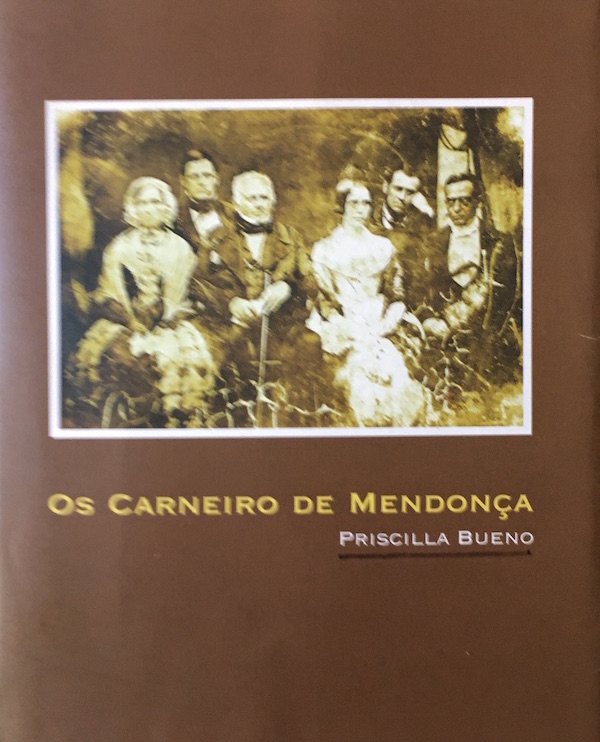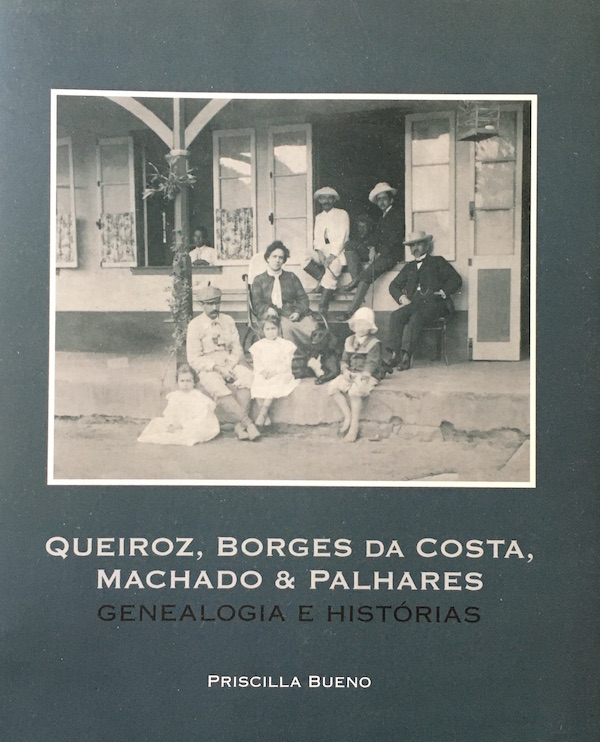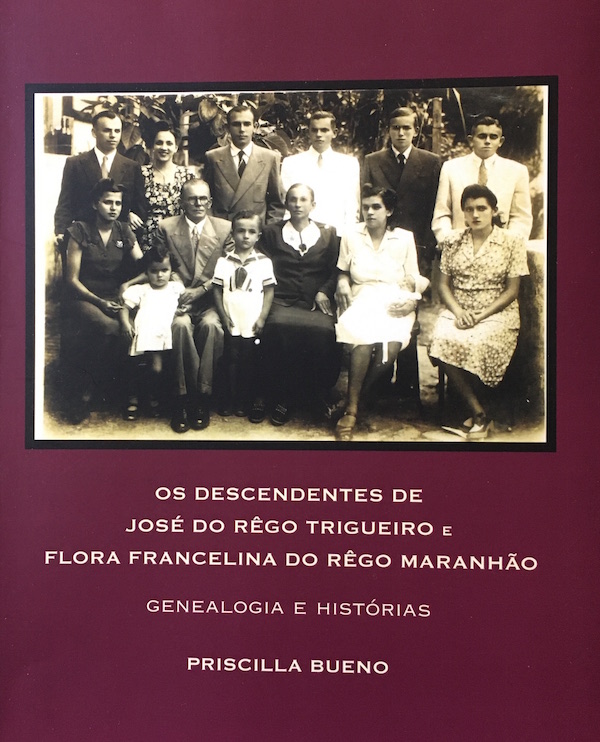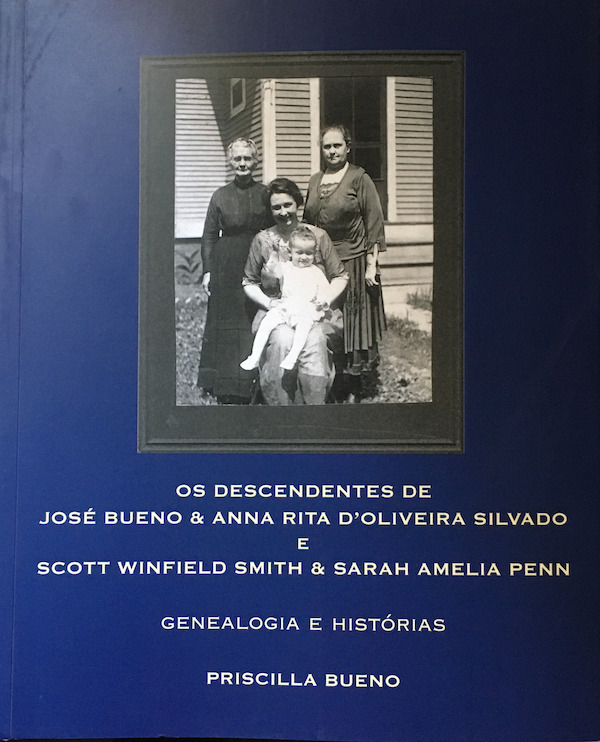Books
OS CARNEIRO DE MENDONÇA by Priscilla Bueno

INTRODUCTION
During my childhood and youth, our family frequently gathered around my grandparents, Anna Amelia and Marcos Carneiro de Mendonça, at the house on Cosme Velho Street in Rio de Janeiro. I also lived in that house until around 1974. My mother’s siblings, who lived in Minas Gerais, would come for vacations, bringing their children. On these occasions, we were 25 people for breakfast, lunch, and dinner. The gatherings in the piano room and the endless conversations around the dining table are vivid and nostalgic memories. This atmosphere of family reunion, which still fascinates me today, was certainly the starting point for my genealogical interest.
In 1975, on the eve of motherhood, the search for my roots became even more important, as I would now contribute to the family history myself, continuing with another generation. I remember asking my grandfather Marcos about the correct order of his and his siblings’ births (Henrique, who had already passed away, Luiz, who was somewhat distant, and Fabio, who was always present), and quickly organizing a document with the family of the four siblings and their descendants. This was so easy and quick that I soon moved on to the search for the next generation, their father Alberto, and his seven siblings. I decided not to be content with just this stage, which led me to identify ten generations that spread mainly across Minas Gerais (Araxá, Belo Horizonte, João Pinheiro, Oliveira, Paracatu, Patos de Minas, Presidente Prudente, and Pirapora), Goiás (Goiânia, Ipameri, Luziânia), Brasília, and Rio de Janeiro, with 3355 direct descendants, and I belong to the eighth generation.
On Christmas of 1976, I made a document with the descendants of Joaquim Carneiro de Mendonça, my great-great-grandfather. At the gathering on the 25th, I handed the document to those present, including Antonio Candido and Gilda de Mello e Souza. This fortunate coincidence would change the course of my research. Antonio Candido is the grandson of Laura Carneiro de Mendonça, sister of Alberto, and since he was a child, he has heard interesting stories about the family from his mother and uncles, which his prodigious memory recalls in minute detail.
From 1981, while working in downtown Rio de Janeiro in an diverse area than genealogy, second-hand bookstores still had many copies of Salvador Moya’s publications, the Genealogical Yearbooks, Genealogical Magazines, and other publications that I bought, forming my small library with numerous interesting pieces of information.
In 1985, my job transferred me to the city of São Paulo. This change was decisive in opening new paths for my research. From then on, more frequent meetings with Antonio Candido inspired me to pursue new paths in investigating the Carneiro de Mendonça family. It was through him that I learned about the tree drawn by Mauricio Limpo de Abreu, which I later located with his granddaughter, confirming the birth order of the children of João Jose and Josefa Carneiro de Mendonça, from whom we descend. It was also from his hands that I received a copy of the inventory of João José Carneiro de Mendonça, located by our cousin Vera Assis Ribeiro in Paraíba do Sul, RJ. And also the Information Bulletin "Trem da História," No. 8/1993, from the Heritage Department of the Calmon Barreto Cultural Foundation in Araxá, with the article "On the Origin of the Families - Carneiro de Mendonça - Carneiro de Paiva," which contains the information that João José is the son of Bento Carneiro de Mendonça and the grandson of Manuel Carneiro Figueira.
For many years, the time I could dedicate to research was quite limited, and progress was mainly due to phone contacts, many letters (later emails), and small trips, creating a network of information where one relative would refer me to another and so on. The Carneiro de Mendonça family intertwines with other families such as Almeida Magalhães, Pimentel Barbosa, Adjuto, Botelho, San Tiago Dantas, Miguel Pereira, Tolentino, Junqueira, Amarante, Correa Pinto, Bulhões de Carvalho, Pitanga, Rezende Costa, Duque Estrada, Nogueira da Gama, Castello Branco, and Monteiro de Barros, to name a few.
Over time, I began to write biographical notes about the relatives. Imposing limits on research is quite difficult; for me, the worst part was not having the courage to discard information about spouses and their families. So much so that I also included their biographical notes but, most importantly, information about their ancestry, confirming the intertwining of families.
Although in my grandfather Marcos’ lecture, "From Arraial da Meia Pataca to Fazenda Itamarati," he suggested that the Carneiro de Mendonça family first settled in Desemboque, curiously in family conversations, Paracatu was always mentioned as the place where the family originated. For Paracatu, the son-in-law of João José Carneiro de Mendonça, husband of his second daughter Ana Luiza, the Viscount of Abaeté, was appointed Ombudsman on September 24, 1823. To better understand the subject and the importance of Paracatu, I traveled there in 1996, spending two and a half days getting to know and talking to the Carneiro de Mendonça family established there, identified as descendants of the siblings Mariana and Francisco de Paula, the third and fourth children of João José. This branch of the family has the highest level of endogamy of the entire family and is closely linked to the descendants of the Minas Gerais matriarch Dona Joaquina do Pompéu.
However, as the research progressed, Araxá stood out more as the place where João José, Josefa, and their children João and Joaquim settled and later moved to Petrópolis and Rio de Janeiro. According to the article in Trem da História, the Carneiro de Mendonça family participated in the founding of the Parish of São Domingos do Araxá in 1791. They had arrived in that region as cattle breeders, attracted by the mineral waters of Barreiro, and received the first land grants starting in 1785. It was there that João José and Josefa were during the Liberal Revolution of 1842 when she, already in her sixties, was "arrested, subjected to humiliation and trial," and because of that, the family playfully refers to her as "the greatest man in the family."
From 2004, I was able to dedicate more time to research, not only to all the documentation I had gathered in those 30 years but also to the National Archives and Metropolitan Curia of Rio de Janeiro, where I found a significant amount of documentation transcribed in the biographical notes (Imperial decrees, baptism and marriage certificates). The website of the Federal Senate,
with Imperial decrees, was also of great value. In the search for my Belgian roots, the archives of the city of Brussels provided numerous interesting pieces of information, such as the birth certificate of Leocadie Procureur, my grandfather Marcos’ mother, and the marriage certificate of her parents, Jules François Procureur and Anne Catherine de Boeck, as well as the identification of several other family members through the census books from 1856 to 1890.
In August 2009, I spent a week immersed in the archives of the Tito Fulgêncio Forum, under the custody of the Calmon Barreto Foundation in Araxá, where I located, among other documents, the will, inventory, and division of assets of Bento Carneiro de Mendonça, precious pieces of information that definitively confirm the family’s presence in that region.
Many thanks are necessary. So many relatives who were willing to exchange information through letters or phone calls, receive me, and help with documents and photographs: Tharcysio Carneiro de Mendonça, Geraldo and Fernando Mello Barreto, Amália Faria, Geraldo Dirceu Oliveira, Amalita Vasconcellos, Madalena Abaeté, Maria Cristina Laet, Father Pedro Guimarães Ferreira, Violeta de San Tiago Dantas Barbosa Quental and her siblings, and many others.
Carlos Reingantz, whom I visited in Petrópolis, taking my first work to him, greatly encouraged me to continue seeking the roots of the family. Minister Mario Gibson Barbosa kindly provided me with information about Dora Vasconcellos.
During the preparations for my trip to Paracatu, my cousin Marcio de Moura Castro suggested that I seek out Dalinha Neiva. This recommendation proved fantastic because when I arrived there, she had already contacted the Carneiro de Mendonça family in the city and scheduled visits and meetings, which undoubtedly made the trip not only productive but also welcoming and pleasant.
While researching on the internet, I found the website "A Raposa da Chapada" by José Aluísio Botelho, a native of Paracatu, living in Brasília. Aluísio provided very important information, including the names of the parents and siblings of Josefa Maria Roquete Batista Franco, later Carneiro de Mendonça, clarifying old doubts and suspicions.
Dom Cassiano, OSB, Steward of the Abbey of Nossa Senhora do Monserrate, was kind and generous in obtaining permission for me to photograph the gravestone of the remains of João José Carneiro de Mendonça, who died in Petrópolis in 1853 and was transferred to the sacristy of the church of the São Bento Monastery in Rio de Janeiro.
Maria Trindade Coutinho Resende Goulart and Keyla Barbosa Machado from the Calmon Barreto Cultural Foundation in Araxá.
Edgardo Pires Ferreira, who has already clarified many doubts and given many pieces of advice. Without his prodding, I probably wouldn’t be here writing this introduction. Roberto Menezes de Moraes kindly reviewed my work and made significant contributions. My son, Guilherme, took some of the photos that appear here and saves me every time there’s a misunderstanding between me and the camera! I also thank Eliana de Moura Castro, dear cousin, friend for all occasions, and patient advisor.

INTRODUCTION
The central figures of the present research are the four grandparents of my grandmother Anna Amelia, and her two sisters, Laura Margarida [Laly] and Maria José [Jujuca].
The paternal grandparents, José Joaquim de Queiroz, who came as a child from Figueiró de Santiago, near Lixa, in the Amarante region of Portugal, and married Amelia Borges da Costa in Brazil, and the maternal grandparents, Luiz Alves Pereira Machado, born in Rio Grande do Sul, who married Anna Xavier Palhares, from a family that came from Portugal.
As often happens, the research takes broader directions and expands, bringing forth curious and interesting information.
By special kindness of my dear friends Lívia de Azevedo and Nuno Tavares, on June 27, 2011, I went to Amarante, from where I left by taxi with Mr. Peixoto, who did not believe in the success of my endeavor. Following the path described by my grandmother Anna Amelia, who had been there in 1935, I cannot express the emotion of finding, on the same winding road, the sign pointing to Figueiró, and in the small village, the traces of the Queiroz family and descendants of my great-great-grandfather’s brother.
The Borges da Costa, whose patriarch José built the house at Cosme Velho Street , where I spent my childhood, youth, and part of my adult life, have dear and close friends among their close or distant descendants. José Mario de Oliveira Ramos gave me access to a diary written by his ancestor José Borges da Costa Junior, which clarified and brought the Borges da Costa to life. José Francisco de Andrade Neves Meirelles, great-grandson of Angélica Borges da Costa, was a source of valuable information about his great-grandmother and Barão de Alves da Conceição, who also happens to be the parents of Uncle Jayme Conceição, who was our neighbor on Cosme Velho Street and part of our history. Finally, Amelia Borges da Costa, the fifth daughter of the patriarch, married the Queiroz who came from Portugal.
José Pougy, his book O Bairro das Águas Férreas (The Águas Férreas district), and our email conversations opened the way for the discovery and identification of the extensive list of properties owned by the Borges da Costa in Cosme Velho.
Luiz Alves Pereira Machado came from the South, possibly from Pelotas, but the archives of that city remained boxed up the two times I tried to use them for research, exacerbated by the local bishop not allowing the FamilySearch project to digitize its information. A bookkeeper with impeccable handwriting, he was a beloved grandfather of the three granddaughters, my grandmother and her sisters.
The Palhares family, of which I knew very little, whose patriarch was a renowned goldsmith, also turned out to be active merchants of materials for the Arsenal de Guerra (War Arsenal) and others.
A new research option that revolutionized access to newspaper information is the Hemeroteca of the National Library. If I could have dedicated my entire life to reading those newspapers, I wouldn’t have had time to find the amount of news related to the family groups to which I had access through this tool.
Another inexhaustible source of information was the collection of letters, many of them exchanged between my great-grandparents José Joaquim de Queiroz Junior and Laura Machado. Early in their marriage, the couple moved to Usina Esperança in Minas Gerais, a place accessible via the Central do Brasil Railway, 4 kilometers from the then Itabira do Campo, now Itabirito. On various occasions, they had to travel. Queiroz Junior went to work in Belo Horizonte or Rio, and Laura, with the daughters, went to Rio to visit her family, spend vacations, or go to the dentist. From the beginning, they agreed to write to each other daily whenever they were apart. Therefore, a two-day trip to Belo Horizonte resulted in four letters, and a 15-day trip to Rio resulted in 30 letters... to the point that there are 998 letters written by Queiroz Jr to Laura, 859 from Laura to him, and countless others between their parents, siblings, daughters, etc., which were carefully preserved by them and later by my grandparents Anna Amelia and Marcos.
The book is divided into four parts, one for each of the grandparents: QUEIROZ, BORGES DA COSTA, MACHADO, and PALHARES, as indicated in the Table of Contents. Since the descendants of the three sisters, my grandmother Anna Amelia, Laly, and Jujuca, would appear in all of them, to avoid repetition, this information appears only in the QUEIROZ section.
I cannot fail to mention the conversations with Antonio Candido, which always give me an understanding of the importance of preserving the family’s history, and Edgardo Pires Ferreira, Roberto Menezes de Moraes, and Eliana de Moura Castro, attentive interlocutors always ready to listen and discuss.

INTRODUCTION
In 1978, for the 90th birthday of Ana do Rêgo Maranhão, Donana, mother of my father-in-law Rossini Gonçalves Maranhão, my mother-in-law Maria Odette asked me to create a family tree to be distributed to the participants of the celebration. Since then, I have cherished the idea of dedicating more time to the Maranhão family, whose name curiously comes from the female branch rather than the male branch, as is more common.
José do Rêgo Trigueiro and Flora Francelina do Rêgo Maranhão, possibly related through the Rêgo lineage, left Quixeramobim in Ceará as survivors of the drought of 1877, and after more than 100 days, arrived in Carolina, Maranhão, where they put down roots.
From this couple descend the Maranhão family members I came to know, and they are the ancestors of my son Guilherme Gonçalves Maranhão and grandsons Pedro and Felipe.
To get to know Rossini Gonçalves Maranhão’s birthplace, my son and I visited Estreito and Carolina in February 2014, and on this occasion, we were warmly welcomed by family members who still lived there, such as Aunt Eunice, at 102 years old, still reciting her poems, Alcina, her daughter, who resides in Belém but was visiting, Cousin Ana Maria, Luiz Orlando, Orlandinho, among others, who provided me with numerous pieces of information. We also visited Araguari, TO, with Aunt Diana’s family.
Guided by the dear Alzira Vasconcelos Rocha Fortes, I was pleased to witness the progress of the construction of the Historical Museum of Carolina, whose inauguration and activities we continue to follow.
Luiz Otávio Fontenelle Gonçalves, son of the late Uncle Abílio and residing in Campinas, was tireless in contacting relatives to obtain updated information and photographs that illustrate this work.
My brother-in-law Paulo Cesar Maranhão helped many times by clarifying events and recalling names. His assistance was undoubtedly invaluable as well.
I appreciate being kept informed of corrections and additions and ask for forgiveness for any inaccuracies.

INTRODUCTION
After extensive genealogical research and delving into the various events of my family’s history, having previously published about my maternal ancestors and having also explored the ancestors of my son Guilherme Maranhão, I now present my perspective on my paternal ancestors: The descendants of José Bueno & Anna Rita d’Oliveira Silvado and Scott Winfield Smith & Sarah Amelia Penn - Genealogy and Stories.
Regarding the Bueno family, the most significant information is the marriage record of my great-grandparents José Bueno and Anna Rita d’Oliveira Silvado, which indicates that José Bueno originated from Niterói. Unfortunately, most of the civil and religious registration documents from that region no longer exist, and the available records do not include the dates that could assist me. Regarding my grandmother’s name, another curiosity is that both of my grandmothers, maternal and paternal, have Amelia as their middle name: Anna Amelia and Maude Amelia.
Another curious fact regarding the names is related to my grandfather Bueno’s father. In the marriage record from July 2, 1881, he is listed as José Bueno, but there is a photo, allegedly of him, with the inscription Augusto José Bueno - October 18, 1891, in Madrid, Spain. I have not found any other references to an Augusto José Bueno.
Undoubtedly, the information gathered would not have been of such magnitude without the assistance of applications, institutions, and, most importantly, people. I must mention the Hemeroteca of the National Library, which allows searching newspapers from across the country, where it is possible to find very interesting news, as well as the website of The Church of Jesus Christ of Latter-day Saints, FamilySearch, with its fantastic revelations.
Upon reading a pamphlet advertising lectures given by my grandfather José Silvado Bueno, in which he mentioned publishing in New York, an article in a Spanish-language magazine in 1920 about his life as a student in the United States, I contacted the New York Public Library, which, in less than 24 hours, located the 10-page article with valuable information about that period.
The research on the Silvado and Smith families proved to be more fruitful. One curiosity concerns my grandmother Maude’s first name, which was spelled with a final "e" in her youth, on her marriage certificate, and in some letters signed by her. However, at a certain point, she started signing only as Maud, and both spellings, Maude and Maud, were used by the family in general. Her year of birth also raises doubts, as there is a notation from her indicating both 1891 and 1892.
Looking at photos from that time, when my grandfather appeared dressed in military uniform, I wondered who could help me in searching for that information. I first contacted The Army Historical Foundation, where Chief Historian Matthew J. Seelinger, after reading the information I sent him about my grandfather, identified that the photos were likely taken at Camp Dodge, the headquarters of the Iowa National Guard training center. He suggested that I contact The Gold Star Museum, where curator Michael Vogt confirmed Mr. Seelinger’s suspicions and was able to identify my grandfather’s enlistment card.
Christopher Pote from The Protestant Episcopal Theological Seminary in Virginia in Alexandria, VA, Jodie from the Office of the Registrar at Coe College in Cedar Rapids, IO, and Katie Sutrina-Haney from Indiana State University, as well as Olivia Garrison, Reference Coordinator from the Special Collections and University Archives at Iowa State University Library - all in the United States - undoubtedly went out of their way to provide additional information for my work. Araken A. Bezerra sent me his book about the Gammon Institute, which tells the story of the Evangelical Institute of Lavras, where my grandfather studied and later returned as a teacher. It was through this institute that the opportunity for his trip to study in the United States in 1913 arose.
My thanks go to Sylvia Bueno Tuthill-Aguirre, a geographically distant cousin who is always attentive to family matters. She has answered many questions and lent me two folders with extensive documentation, letters, and photographs that undoubtedly clarified, added to, and illustrated my work.
Donna Galbraith Short contributed a wealth of information and photographs of the Smith & Penn families. Thank you so much for your contribution!
Eliana de Moura Castro, my maternal cousin and dear friend, is always available and attentive whenever I need to talk, share news, or seek advice.